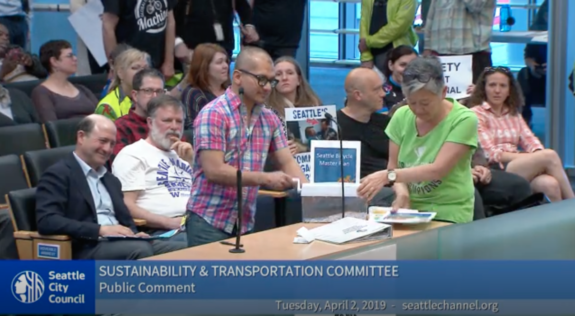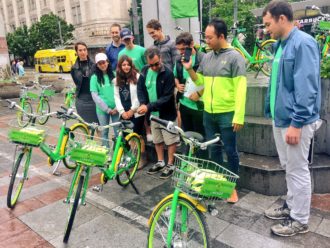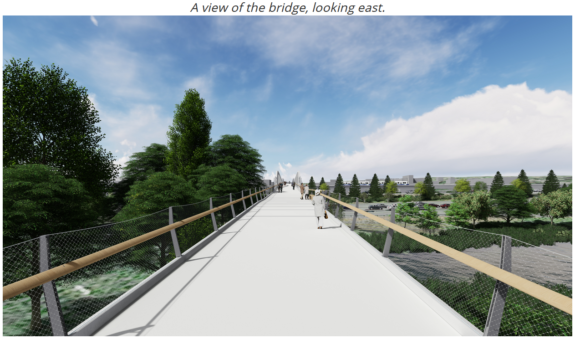It’s time for the final Bike News Roundup of news from the 2010s!
First up, if you didn’t catch Angie Schmitt’s recent talk about America’s pedestrian safety crisis, Rooted In Rights was there to record and stream it:
By
| Posted
It’s time for the final Bike News Roundup of news from the 2010s!
First up, if you didn’t catch Angie Schmitt’s recent talk about America’s pedestrian safety crisis, Rooted In Rights was there to record and stream it:
By
| Posted


2019 was a red letter year for biking in Seattle. The number of trips people are taking by bike broke through some kind of barrier in the past year, and bike counters across town are clobbering previous records (we’ll have more on that in the new year when the final numbers are in, so stay tuned). So some combination of bike network improvements and bike share and e-bike sales and bike culture have all worked together to make 2019 the bikiest year in Seattle history.
But back in the spring, it hardly felt like this would be a successful biking year for Seattle. Despite signs that the city’s bike investments were working, Mayor Jenny Durkan canceled the 35th Ave NE bike lanes at the last minute even though they were already designed and contracted for construction. She also released a new bike workplan that dramatically scaled back the city’s previous ambitions, especially in the southend. Her decisions triggered a big backlash and a protest at City Hall as people challenged what they saw as her abandoning the city’s Bicycle Master Plan, Climate Action Plan and transportation equity.
This energy flipped the year around. 2019 started with delays and cancellations, but it is ending with record ridership, major bike lane construction and big political momentum. You all did this.
For her first year in office, there was a lot of uncertainty. SDOT went a year without a Director, and projects were getting delayed. In many ways, Mayor Durkan’s springtime anti-bike decisions reignited popular energy in support of the Bike Master Plan, both for the sake of making biking easier and safer and as a way to combat climate change. The city’s biggest transportation advocacy organizations, including Rooted In Rights, Seattle Neighborhood Greenways, Cascade Bicycle Club and the Transit Riders Union had recently joined together as the Move All Seattle Sustainably (“MASS”) coalition. MASS organized a rally at City Hall and ride down 4th Ave to demand that the city build the biking and safety projects in its transportation plans, including key parts of the downtown bike network like 4th Ave.
The City Council passed a bike safety ordinance all but requiring SDOT to build the projects in the Bike Master Plan during repaving projects. If there are serious reasons why they can’t do so, they need to explain themselves to the Council’s Transportation Committee. This doesn’t guarantee that projects won’t be canceled in the future, but no Seattle Mayor should be able to simply cancel a bike lane project on a whim again. It will require explanation to the Council and the people first.
People also organized to support budget additions for funding key south Seattle projects, including the Georgetown to South Park Trail and a north-south bike lane on either Beacon Ave or MLK. The City Council approved these additions in the final budget. (more…)
By
| Posted

Lime announced today that they will be pulling their e-bikes from Seattle streets December 31.
This follows a week and a half of rumors that the company was shutting down, rumors the company denied to both Seattle Bike Blog and The Urbanist. As recently as December 15, a company spokesperson told Seattle Bike Blog that Lime would remain in operation until at least March, around the time when the long-awaited scooter pilot is due to be rolled out.
But an email to users on Christmas Eve, Lime announced they would, indeed, be shutting down service, though they “remain very committed to working with the City of Seattle to create a robust mobility program in the Spring that includes a mix of free-floating scooters and improved bike options that are a priority to the City.”
Lime was the last of the original three bike share companies to launch in Seattle in the summer of 2017. Spin, one of the other three original companies, has since switched to scooters and has stated in the past that they are interested in operating scooters in Seattle.
The loss of Lime comes just as Sound Transit is preparing a major multi-month service reduction on light rail service downtown as they work to connect the East Link tracks to the existing line. Bike share could help relieve pressure on the crunched downtown trains, so let’s hope JUMP sticks around.
More details from Lime: (more…)
By
| Posted
Some of the most significant changes to Washington State’s rules of the road in recent history will take effect January 1, when SB 5723 becomes law.
Perhaps the biggest and most exciting change is that people driving will now have clear instruction on how to safely and legally pass someone on a bike (or riding a horse, a carriage or tractor):
The new law also clarifies the responsibilities for people biking. If there is enough space in the lane for safe passing, people biking must ride to the right to allow passing. But you are not required to squeeze to the right if there is not enough space in the lane for safe passing or if “other conditions make it unsafe to do so.” So if there is debris or damaged pavement or parked cars with doors that could swing open at any moment or another road user, you are not required to move right.
The law passed during the 2019 legislative session with wide bipartisan support (70-26 in the House, 43-5 in the Senate) and is in large part thanks to the advocacy work of Washington Bikes.
These changes are very favorable to people biking and set a new standard for safe passing laws in the U.S. They make it clear that a person’s safety is paramount. No, they won’t suddenly make it super comfortable to bike on the many streets and highways in our state that have no bike lanes or adequate shoulders. But they at least remove a lot of the doubt about what is legally expected of everyone.
Of course this brings us to the big questions: Will people know the law has changed? And will it be enforced?
By
| Posted
UW Researcher Julie McCleery says she has found that King County kids are not getting the hour of exercise per day that the CDC recommends. She also found that girls are less likely to get their exercise than boys, and kids from immigrant families are being left behind.
McCleery is largely focused on how organized sports can help kids stay active, and that’s great. But her story should also be a guide for safe streets advocates and departments of transportation. Because a sport is one way to get exercise, but walking, biking and generally playing outside work, too. And unlike with sports, walking, biking and playing outside don’t require joining a team or following a schedule.
“Further, we learned that children being raised in immigrant families were less likely to play at parks near their homes,” McCleery wrote. She does not talk about bike lanes or trails, but that is worthy of future study.
It’s hard to think of many things more important than the health of children. Part of the safe streets vision is that neighborhood space could return to the neighborhood kids. Everyone should feel safe letting their kids play outside their homes, and people driving should feel like guests on streets the neighborhood kids own. But aside from just creating infrastructure, we also need to make sure everyone has a sense of ownership of our public spaces, whether that’s a park or a bike lane or a street.
By
| Posted
Editor’s Note: This post introduces a new type of post on Seattle Bike Blog I am calling a “shortcut.” Shortcuts could be many things, but they will all be short. They could be a quick link to a survey or advocacy alert. Maybe there’s a project update that doesn’t need much new reporting. Or maybe another news outlet has reported something I think you should all see. I am hoping that Shortcuts will be a way to get more news to you more quickly and create more prompts for comments and conversation, but in a way that differentiates these quick posts from my longer posts with more original reporting or commentary. So let me know what you think in the comments below.
 It’s really happening! Work is just weeks away from starting on the Northgate bike/walk bridge over I-5, and the goal is still to have it open by the time Northgate Station begins light rail service in September 2021. It’s a complicated project, so it could be cutting it close depending on construction delays.
It’s really happening! Work is just weeks away from starting on the Northgate bike/walk bridge over I-5, and the goal is still to have it open by the time Northgate Station begins light rail service in September 2021. It’s a complicated project, so it could be cutting it close depending on construction delays.
The start of the project has already been delayed several times, including a major redesign after the original design’s bids came in much higher than budgeted. The trail will be 16 feet wide and connect the station to North Seattle College, dramatically increasing the number of homes west of I-5 within a short walk or bike ride of the new light rail station.
SDOT is hosting a series of open houses the second week of January for people who want to learn more about the project or project construction. Details from SDOT: (more…)
As a supporter, you help power independent bike news in the Seattle area. Please consider supporting the site financially starting at $5 per month:





